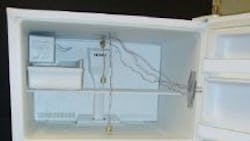NIST calls ice makers energy hogs
It turns out that the ice makers found in modern refrigerators burn a lot of energy. Specifically, they boost the energy consumption of a refrigerator by between 12 and 20%. Much of that additional energy cost comes from the electric heaters used to release the ice from the molds.
So say researchers at the National Institute of Standards and Technology who tested four different kinds of refrigerators for energy consumption. Only about a quarter of the energy burned by the ice maker goes into freezing the ice cubes. "There are substantial opportunities for efficiency improvements merely by optimizing the operations of the heaters associated with the ice makers" or by introducing a more efficient alternative technology, reports NIST mechanical engineer David Yashar and guest researcher Ki-Jung Park.
Currently, federal minimum efficiency standards for refrigerators don't take ice maker energy consumption into consideration. Ditto for the voluntary Energy Star program. But the results of the NIST research have gotten the attention of the Dept. of Energy. DOE says it will increase the minimum efficiency standard for fridges by 25% over the current level, starting in 2014. DOE also intends to incorporate the energy used by ice makers into its regulatory test.
One problem: No widely accepted test for ice makers was available when DOE announced these intentions. So DOE plans to add 84 kW-hr to the energy efficiency rating of every refrigerator equipped with an ice maker across the board, Yashar explains.
Once a reliable, straightforward test is available, he adds, DOE will eliminate the "placeholder" energy consumption and start using test results for in efficiency ratings.
Consequently, Yashar and Park evaluated several different approaches to measuring the energy consumption of ice makers. Their goal was to identify a method that consistently yielded accurate results but did not add substantially to the complexity of appliance energy consumption tests under current regulations.
One of their conclusions: Just using calculations to estimate the ice-maker energy consumption won't work. The energy consumed during ice making is based on the actual mass of ice produced, which must be measured and not estimated. Also, this approach is based on an assumed COP of the system, which is not a traceable or reliable quantity.
Researchers concluded the ice-making energy consumption should be determined by measuring the energy consumption of the unit while actively producing ice and subtracting the energy consumption of the unit while not actively producing ice. They say each of these quantities should be determined by interpolating the results of individual measurements to a set of compartment temperatures; specifically 3.9 ºC in the refrigerator compartment and -17.8 ºC in the freezer compartment.
The full report is available free to the public and can be found here:
